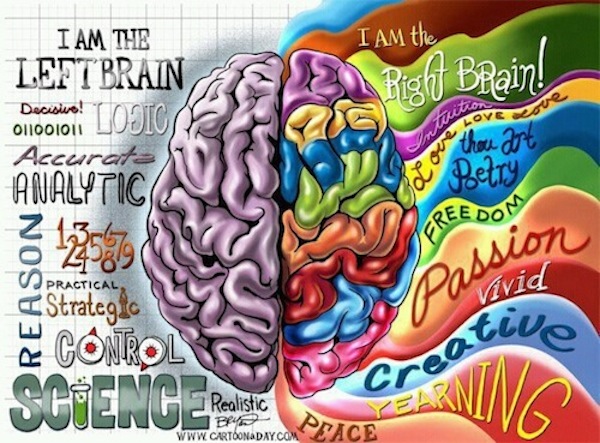Are you analytical and logical? If so, you are likely to be labeled as being “left-brained”. On the other hand, if you are emotional and creative, you are more likely to be labeled “right-brained”. And so the popular narrative of brain function continues. But this generalized distinction is a myth. Our brains’ hemispheres do specialize, but not in such an overarching way. Recent research points to another distinction: top brain and bottom brain.
From WSJ:
Who hasn’t heard that people are either left-brained or right-brained—either analytical and logical or artistic and intuitive, based on the relative “strengths” of the brain’s two hemispheres? How often do we hear someone remark about thinking with one side or the other?
A flourishing industry of books, videos and self-help programs has been built on this dichotomy. You can purportedly “diagnose” your brain, “motivate” one or both sides, indulge in “essence therapy” to “restore balance” and much more. Everyone from babies to elders supposedly can benefit. The left brain/right brain difference seems to be a natural law.
Except that it isn’t. The popular left/right story has no solid basis in science. The brain doesn’t work one part at a time, but rather as a single interactive system, with all parts contributing in concert, as neuroscientists have long known. The left brain/right brain story may be the mother of all urban legends: It sounds good and seems to make sense—but just isn’t true.
The origins of this myth lie in experimental surgery on some very sick epileptics a half-century ago, conducted under the direction of Roger Sperry, a renowned neuroscientist at the California Institute of Technology. Seeking relief for their intractable epilepsy, and encouraged by Sperry’s experimental work with animals, 16 patients allowed the Caltech team to cut the corpus callosum, the massive bundle of nerve fibers that connects the two sides of the brain. The patients’ suffering was alleviated, and Sperry’s postoperative studies of these volunteers confirmed that the two halves do, indeed, have distinct cognitive capabilities.
But these capabilities are not the stuff of popular narrative: They reflect very specific differences in function—such as attending to overall shape versus details during perception—not sweeping distinctions such as being “logical” versus “intuitive.” This important fine print got buried in the vast mainstream publicity that Sperry’s research generated.
There is a better way to understand the functioning of the brain, based on another, ordinarily overlooked anatomical division—between its top and bottom parts. We call this approach “the theory of cognitive modes.” Built on decades of unimpeachable research that has largely remained inside scientific circles, it offers a new way of viewing thought and behavior that may help us understand the actions of people as diverse as Oprah Winfrey, the Dalai Lama, Tiger Woods and Elizabeth Taylor.
Our theory has emerged from the field of neuropsychology, the study of higher cognitive functioning—thoughts, wishes, hopes, desires and all other aspects of mental life. Higher cognitive functioning is seated in the cerebral cortex, the rind-like outer layer of the brain that consists of four lobes. Illustrations of this wrinkled outer brain regularly show a top-down view of the two hemispheres, which are connected by thick bundles of neuronal tissue, notably the corpus callosum, an impressive structure consisting of some 250 million nerve fibers.
If you move the view to the side, however, you can see the top and bottom parts of the brain, demarcated largely by the Sylvian fissure, the crease-like structure named for the 17th-century Dutch physician who first described it. The top brain comprises the entire parietal lobe and the top (and larger) portion of the frontal lobe. The bottom comprises the smaller remainder of the frontal lobe and all of the occipital and temporal lobes.
Our theory’s roots lie in a landmark report published in 1982 by Mortimer Mishkin and Leslie G. Ungerleider of the National Institute of Mental Health. Their trailblazing research examined rhesus monkeys, which have brains that process visual information in much the same way as the human brain. Hundreds of subsequent studies in several fields have helped to shape our theory, by researchers such as Gregoire Borst of Paris Descartes University, Martha Farah of the University of Pennsylvania, Patricia Goldman-Rakic of Yale University, Melvin Goodale of the University of Western Ontario and Maria Kozhevnikov of the National University of Singapore.
This research reveals that the top-brain system uses information about the surrounding environment (in combination with other sorts of information, such as emotional reactions and the need for food or drink) to figure out which goals to try to achieve. It actively formulates plans, generates expectations about what should happen when a plan is executed and then, as the plan is being carried out, compares what is happening with what was expected, adjusting the plan accordingly.
The bottom-brain system organizes signals from the senses, simultaneously comparing what is being perceived with all the information previously stored in memory. It then uses the results of such comparisons to classify and interpret the object or event, allowing us to confer meaning on the world.
The top- and bottom-brain systems always work together, just as the hemispheres always do. Our brains are not engaged in some sort of constant cerebral tug of war, with one part seeking dominance over another. (What a poor evolutionary strategy that would have been!) Rather, they can be likened roughly to the parts of a bicycle: the frame, seat, wheels, handlebars, pedals, gears, brakes and chain that work together to provide transportation.
But here’s the key to our theory: Although the top and bottom parts of the brain are always used during all of our waking lives, people do not rely on them to an equal degree. To extend the bicycle analogy, not everyone rides a bike the same way. Some may meander, others may race.
Read the entire article here.
Image: Left-brain, right-brain cartoon. Courtesy of HuffingtonPost.

